I REMEMBER MONO

above: My first hi-fi component was this Lafayette speaker system, a
$15 enclosure with a $10 driver inside it.
This year is not only Audio's 50th anniversary but my 15th year here, my 35th as an audio journalist. It's also about my 45th year as an audio enthusiast, which means I started very young. What got me going was an RCA jack on the back of, appropriately, an RCA big-screen TV. ("Big screen" meant 16-inch back then, and neighbors were convinced we'd go blind from its vast glare.) As soon as I figured out what the jack was for, I bought my first music system: an RCA 45-rpm changer and a mix of records, all for just $25 in accumulated birthday money. (As I recall, the records included Mario Lanza's Great Caruso album, one actual Caruso record, "The Thing" and five other sides by Phil Harris, and a Spike Jones single.) The sound was actually quite good. That TV had RCA's Golden Throat sound system-which consisted, in this case, of an 8-inch speaker in a wooden baffle just T above the floor and, naturally, a tube amplifier.
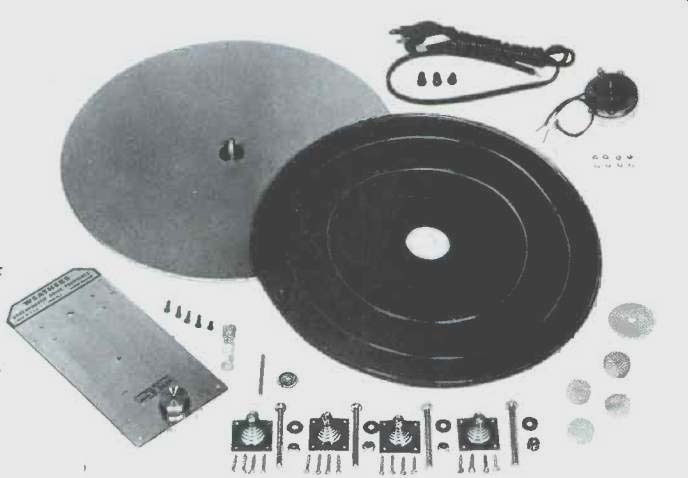
A marvel of simplicity, the Weathers turntable kit cost
only $34.50, though I splurged and spent $15 more for its motorboard and
base.
My folks and I soon realized that 45s alone would not do, so Dad bought a three-speed Webcor changer to replace my one-speed RCA. The Webcor had a flip-over ceramic cartridge, with a sapphire stylus on one side for 78s and, on the other, a smaller-tipped diamond for LPs.
For music off the air, we had a Motorola AM/ FM radio in the dining room and, eventually, a terrific Delco AM radio in our car.
I first heard about hi-fi from my high-school chem teacher, who showed me the first component sound system I'd ever seen. He tried to show off how loud it could play, but I was not convinced at first. "That doesn't sound so loud to me," I said, and he replied, "Then why are you shouting?" I was so used to the throaty distortion of radios and phonographs at high volume settings that I hadn't realized that a music system could be louder by far and still sound dean.
We couldn't afford a component system, but I nearly talked my folks into a crisp-sounding Stromberg-Carlson chairside console-nearly, but not quite. Instead, as I got ready for college, I bought a $10 Lafayette Radio SK-98 8-inch driver in a $15 Lafayette Troubadour bass-reflex speaker cabinet and spent $10 on a Grommes-built, 12-watt Realistic integrated amp my girlfriend's father sold me. (Or was that $12 for a 10 watt amp?) My music source was still the Web cor. By now, I'd heard about stylus force, so I figured out the Webcor arm's force adjustment, a spring that could fit into any of three holes, and moved the spring to the hole that gave the lightest tracking. Then I bought a stylus gauge to see what force that yielded. The gauge could measure from 0 to 20 grams--and the arm bottomed it with a loud "clunk"!! Time to replace the Webcor.
Its successor was a Weathers turntable kit and a Dynaco/B&O integrated arm and cartridge (which could track at a then-remarkable 2 grams), the cheapest good stuff I could find. Like most Weathers products, the turntable was unique. Turntables of the day had heavy platters, whose momentum ensured speed constancy and smoothness, driven by heavy motors through hard-rubber pucks, or idlers. When the turntable wasn't spinning, you had to pull the puck away from the motor shaft and turntable rim; otherwise, it would develop flat spots, which would cause wow and flutter later.
The Weathers, by contrast, relied on an electric-clock motor for speed control. Since that motor had little torque, the platter had to be an ultra-light aluminum stamping. With such low torque, the drive and gearing could come from a soft rubber wheel, which didn't have to be moved away when not in use because it couldn't deform permanently. Whatever other turntables did, the Weathers did the reverse; sometimes, it even ran in reverse, until I stopped and restarted it.
The Weathers came out long before the famous AR turntable, which also used a light-duty motor. But the Weathers wasn't the first to do this, either. Even before I entered college, Stromberg-Carlson had a single-play turntable with a light motor that introduced an even more significant idea: Its platter and arm were mounted to a "floating" sub-platform hung from springs beneath the turntable base's top plate. (AR usually gets credit for that idea, too.) By now, I was meeting other hi-fi buffs, and learning from them. One guy in my dormitory was still using a 45-rpm changer like the one I'd started out with, only hi was feeding a 10-watt Pilot amp that drove a Klipschorn. Since he liked jukebox bass he listened mainly to the hot new R&B records, running his changer's ceramic cartridge (which needed no RIAA equalization) into the Pilot's RIAA input and then turning up the loudness-compensation and bass controls as far as they could go. From my room, the next stairwell over and three flights up in a steel-framed masonry building, I could follow the beat if I walked bare foot. I wonder how boomy his car stereo would be if he were a kid today.
I soon replaced my used 12-watt amp with a used 20or 25-watt Heathkit power amp and a Heathkit WAP-2 preamp that, like many preamps at the time, drew its operating voltages from the amp.
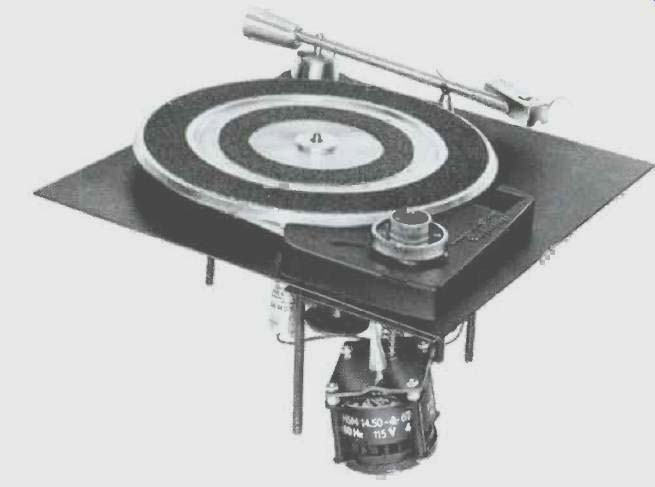
Forgotten today, the Stromberg Carlson Perfectempo turntable
introduced significant innovations.
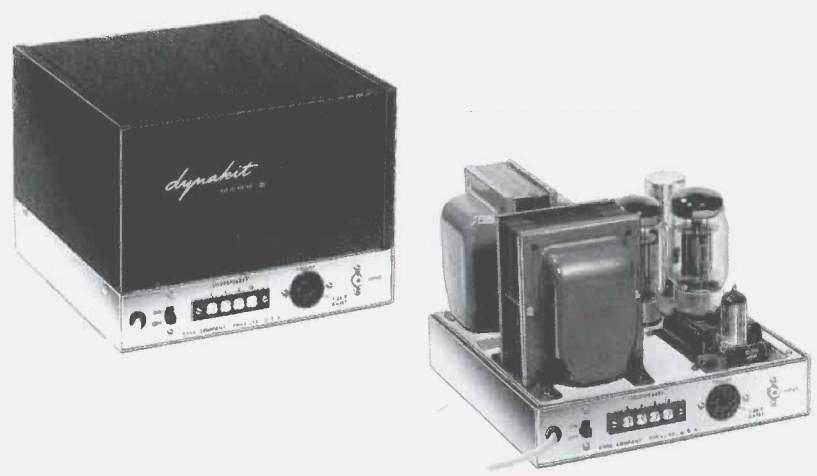
The octal socket on the Dynakit Mark III amp could power Dyna's
own preamp or a Heathkit preamp like mine.
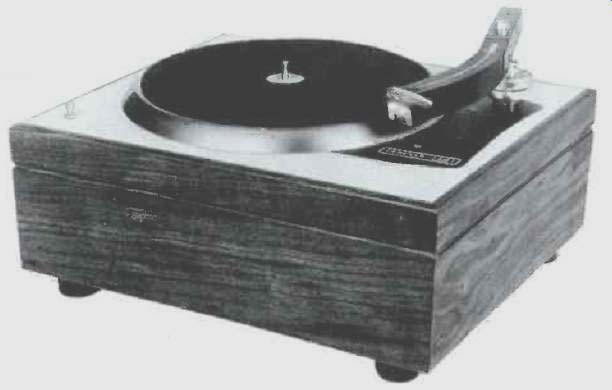
Reputedly, this sleek Fairchild turntable and arm were designed
by Raymond Loewy.
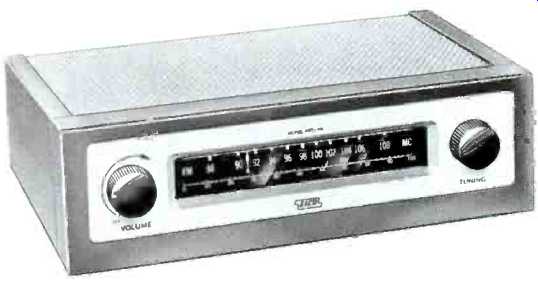
The "exclamation-point" dial pointer on Eico's HFT-90
tuner was a magic eye center-tuning indicator.
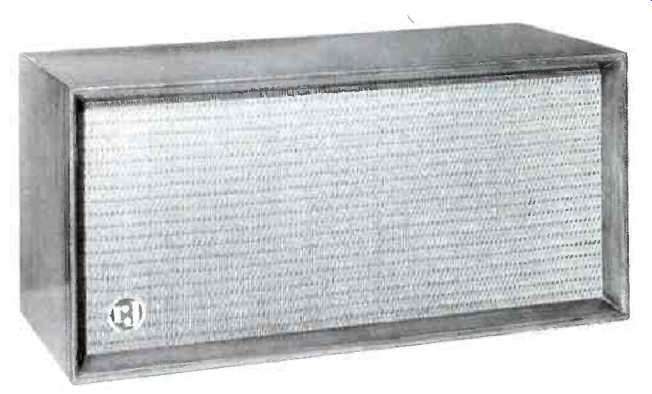
Putting my Lafayette 8-inch speaker in this R-J cabinet enhanced
its sound; replacing the Lafayette with a Wharfedale driver improved the
sound even further.
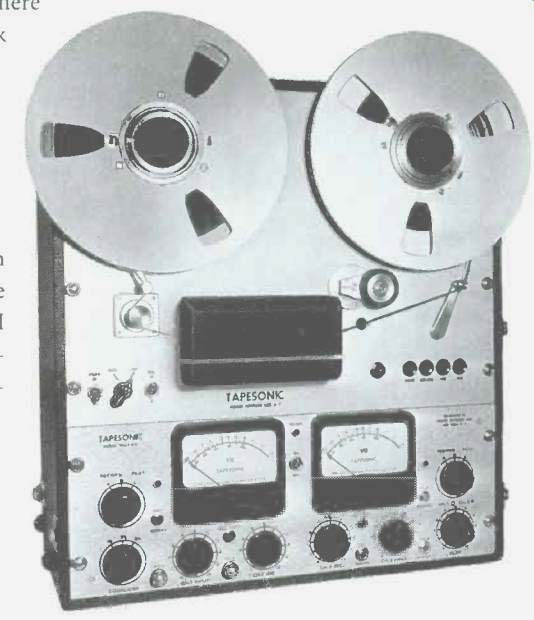
My Premier Tapesonic served me long and well.
When stereo came, I swapped the Heathkit amp against a 60-watt Dynakit Mark III amp, while my roommates bought a matching amp, a pair of speakers (AR-1s), and an H. H. Scott stereo preamp and tuner. The only "binaural" broadcasts were AM/FM simulcasts, so the tuner had independent AM and FM sections that could feed separate channels. Each section was tuned by its own vernier-crank dial, which made station selection a deliciously sensuous experience.
For record-playing, we used a glamorous looking Fairchild turntable and arm, probably with a Fairchild cartridge.
When I moved to a single room, I could no longer share roommates' equipment. So I shifted back to mono, using my Dyna amp to power my old Heath preamp. My speaker was still the 8-inch Lafayette SK-98, which you might call a 1 1/2-way driver: The center section of its cone was stiffened and decoupled from the outer section to enhance its treble output. The tiny, honky $15 enclosure had by now given way to an R-J enclosure designed for a Wharfedale driver.
When I bought another R-J, complete with Wharfedale driver, I ran it in parallel with the R-J/Lafayette system; the combo seemed to sound better than either one alone.
(When I finally graduated to my own stereo system, I replaced the Lafayette driver with another Wharfedale, so the channels would match.) One fine spring day, a girl from Bennington came by and cried out, "You've got my daddy's speakers!" I started to sputter that I'd bought them fair and square, only to discover that her father was Bill Joseph, who'd designed the R-Js.
I bought and built an Eico HFT-90 tuner kit, but I soon swapped it for a Magnecord PT-6 tape recorder. That was cheap for a PT-6, but the prior owner had disassembled it and couldn't get it back together. Using a Sams PhotoFact service manual, one of my ex-roommates put it back together for me.
By joining the college radio station, WYBC, I got my hands on fancier stuff, such as an Ampex 350, and started learning about mikes and how to use them. (We used to tape or broadcast events around the campus and did a weekly live remote from a nearby jazz club.) I also got my hands on some Magnecord parts the station was no longer using, including reel extension arms and an intriguing head assembly.
The extension arms enabled me to use 10 1/2-inch reels for the first time. The arms bolted to the sides of the PT-6 recorder and were driven by rubber belts that connected them to the recorder's reel holders. That was a big advance, because the only way I could get good fidelity from the PT-6 was to run it at 15 ips; at that speed it could record and play out to 15 kHz, while its response at 7 1/2 ips ran out to only 7.5 kHz. The reel arms worked fine for recording and playback, but the Magnecord's reel motor torque was a bit low for good fast forward and rewind; fast-winding took forever to get up to speed, and the reels shook like mad once it did so.
The head assembly was "binaural," with staggered half-track record/play heads for each channel and a full-track erase head. I figured I could use these to make half-track mono recordings instead of full-track, cutting my tape costs in half. Since I'd doubled that cost by running at 15 ips, that would put me right back where I'd started. The new head assembly bolted in where my separately housed full-track erase and record/play heads had been. I could now play half-track tapes, but I couldn't record a second track without simultaneously erasing the first one. To get around that, I experimented to find what resistance would match the erase head's impedance at the PT-6's bias frequency, and then I installed a double-pole double throw switch that would select either that resistance or the erase head. (Just bypassing the erase head would increase the bias current to the record head.) I'd switch the erase head on when I taped track 1, then switch it off when I turned the tape over for track 2. As long as I remembered to do this, it worked fine.
Eventually, a few years after college, I replaced the Magnecord with something far niftier, if equally outré, a Premier Tapesonic. Premier Electronic Labs was basically a one-man outfit, but it built fine decks for very little money. (My Tapesonic, a 15-ips machine that took 10 1/2-inch reels, cost me $565.) Marty Gersten, later a speaker designer at Rectilinear and Ohm, worked there when he was very young. He told me that the company used surplus parts whenever possible; when a given part was no longer available or no longer cheap, Premier's proprietor would redesign the deck around some other part. My Tapesonic was a half-track stereo model with a two-speed motor; by attaching a capstan sleeve, I could increase its speeds from 3 3/4 and 7 1/2 ips to 7 1/2 and 15 ips. I had the machine built into two cases instead of one; I was doing a lot of live recording up in choir lofts, and I preferred climbing all those stairs with a 45-pound package in each hand than with an 80-pounder in one hand and nothing in the other. Eventually, I made two small modifications of my own: I took an empty metal box that had once contained 4AG fuses, glued it to the deck to hold the capstan sleeve when I wasn't using it, and lined it with moleskin so it wouldn't scratch. I also added a switch to disconnect the take-up motor, so I could dump unusable sections of a tape into the wastebasket when I was editing.
By the time I bought my Tapesonic, in the middle '60s, the hi-fi world and I were going mainstream. Products were becoming more standardized, and I was becoming able to afford them. As a reviewer, however, I did get to try some interesting components that history has since passed by.
One was the 3M Revere tape cartridge system. It was no match for my 15-ips Tapesonic, but I thought it certainly outperformed my antique Magnecord. It was also the easiest-loading changer I've ever used; the cartridges sat in loose stacks, with the input stack slowly sinking as the output stack rose. If you wanted continuous music, all you had to do was come by every few hours and shift some cartridges from the output to the input stack.
Another interesting component was an Akai open-reel tape deck that doubled as a video recorder. In either mode, it took 10 1/2 inch reels of quarter-inch tape. For audio, you'd use standard tape and thread it over a standard head assembly; for video, you'd use a special tape and thread it around a big head drum near the middle of the deck's top plate.
Then there were quadraphonic oscilloscopes, designed to help you set up your system by checking signal levels in each of its four channels. Today's surround systems use a better method, playing test tones through one speaker after another while you adjust levels from wherever you are sitting. But the quad 'scopes did have other functions, such as displaying audio waveforms. Pioneer's quad 'scope (which I still have, together with a matching four-channel preamp) could also display the output from a tuner's multipath jack; when I lived in the canyons of Manhattan, it was a big help in aligning my antenna.
My first CD player, a Technics, had a vertical layout, with a window through which I could watch the disc spin. It looked exciting then but would just look exotic today, 15 years later. Which makes me wonder: How long will it take before today's gear looks as exotic, and evokes as much nostalgia, as the stuff I scrounged together way back when?
(adapted from Audio magazine, Jun. 1997)
= = = =